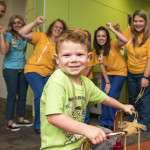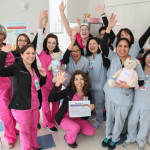It is the beginning of a new year, and what I appreciate about January is that so many people have such a renewed energy. There is a fresh note of promise ushered in that reinvigorates people around postponed goals and good intentions. The new year is a welcome reset button for many, and if a holiday moves someone closer to positive change, that is indeed a good thing. But personally, I don’t reserve hopeful energy for the new year – I strive to dwell in possibility at all times. I believe, especially at Texas Children’s, we are surrounded by opportunities to make the impossible a reality, every single day.
Perhaps this is why The Art of Possibility is one of my favorite books. My wife Shannon recommended this book to me, and after I read it, it became one of the books I most often recommend to others. It is written by a fascinating couple – conductor Benjamin Zander and his wife, psychotherapist Rosamund Stone Zander. I was of course struck immediately by the title, but as I got into reading the book, I realized how closely aligned it was with many of my personal beliefs and leadership maxims.
For instance, the book emphasizes everyone’s ability to lead, pursue possibility and experience positive results. It is seemingly such a simple notion, but in reality, this is an incredibly powerful mindset. If we believe hope is around every corner or that something wonderful – and perhaps even life changing – is always within our grasp, imagine the excitement and anticipation that would fill each of us. Imagine how resourceful we might become and the fervor with which we would pursue possibilities.
You know, ever since I was 16, and I decided that I wanted to go into health care and some day be a CEO of a major U.S. hospital, I have thought about the kind of leader I would be and what I could do in an organization. However, what I was struck by even when I was very young, when I was in college, through grad school and when I started my career in the Texas Medical Center nearly 40 years ago, was that health care and medicine was filled with so much gloom and doom. In health care, there are always diseases for which a cure seems elusive, there are more patients than caregivers, more needs than resources. And there is loss – loss of life, loss of jobs, and, if we are not careful, loss of hope.
I observe this even today about our industry. It is a volatile and often unpredictable industry. Yet, in the midst of this, my hope is not diminished, and my outlook is unchanged. If anything, because of what we have already accomplished in such short time at Texas Children’s, I am even more inspired to find the answers and the resources to create a future where nothing is impossible.
All of the gloom and doom – I think we have to tune that out. Of course, at first you must digest information to understand your challenges. But then, push that out. Do not use negative information to predict the future. Focus instead on creating the future that works for you and works for Texas Children’s. That is what we have always tried to do here. We are not trying to predict the future, we are trying to create the best future for our organization and for children and women everywhere. We dwell in the possibilities of Texas Children’s.
And of course we have had many examples over the years that demonstrate how we have truly explored the art of possibility and the extent of our aspirational goals and imagination. The Jan and Dan Duncan Neurological Research Institute, Texas Children’s Pavilion for Women, Texas Children’s Pediatrics, Texas Children’s Health Plan, even installing the submarine vaulted doors in the Abercrombie and West Tower basements to prevent flooding. Those are all examples of how at Texas Children’s, we were thinking outside of the box instead of simply wringing our hands and being worried. We were on the outside of the box, looking up, thinking about solutions to problems before they even came to light.
That is why Texas Children’s is dynamic and upbeat, positive and unified. We have one mission, one culture, and we are one amazing team. And that culture, with those characteristics, dwelling in possibilities every single day, creates a performance dividend – every single minute and every day and every year at Texas Children’s. So through better times or tough times, Texas Children’s has always been able to remain strong and flourish. We do not suspend our time and efforts and our ideas in the face of uncertainty. We place our energy in creating our own future at Texas Children’s. We dream audaciously and focus on seizing the power of potential. Because we know at Texas Children’s, every day is a new day and a new chance to passionately pursue possibility.


 At Texas Children’s, we lead decisively and boldly, always focused on the vision we have shared since our founding. Growing our workforce, adding new programs,
At Texas Children’s, we lead decisively and boldly, always focused on the vision we have shared since our founding. Growing our workforce, adding new programs, Structure is key to supporting our vision and actually being able to realize it. Simply saying health care should be available when and where children need it is not enough. We are thought-leaders and action-takers. So when we see a need, we respond to it very tangibly, and we provide the structure to support our response.
Structure is key to supporting our vision and actually being able to realize it. Simply saying health care should be available when and where children need it is not enough. We are thought-leaders and action-takers. So when we see a need, we respond to it very tangibly, and we provide the structure to support our response.